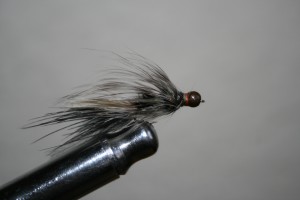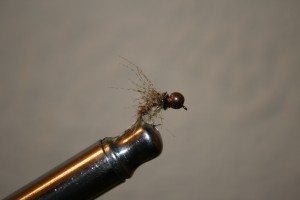Best Adirondack Fly Selections – Search Patterns
Hi again. In this week’s segment of the Best Adirondack Fly Patterns I’m going to unveil my favorite all purpose search and destroy fly selections.
Peacock-Backed Wooly Bugger

This one is a no brainer, right? Wooly Buggers. Well, not so fast. Years ago my father was experimenting with the best possible combination of materials to get a Wooly Bugger looking and working its best. He discovered this post from Mike Hogue and decided to perfect the pattern. I believe he has done just that with the addition of perl flash, olive/black variegated chenille and black hackle. My own preference is to tie this pattern with a copper bead and ribbing.
Peacock is one of my favorite materials to begin with — it has that natural iridescence that makes it look buggy and enticing at the same time. So when you pull down the hackle fibers on the Bugger and tie in the peacock shell-back, the profile you give the fly just looks much more interesting, and for whatever reason it seems to be more enticing to a trout. This pattern works any way you fish it – dry in the film, dead drifted, skittered, quartered downstream, upstream, swung, and even simply held in the pocket from an upstream position.
I truly don’t go fly fishing without this pattern stocked, and I don’t fish a bugger without the peacock backing anymore, I just won’t do it.
Tic-Tac

The Tic-Tac is my take on a small Wooly Bugger, usually tied in a size 12 on a curved caddis hook. I believe its small size contributes to its appeal — that the trout feels like it can just nip its meal off without trouble, just like it’s popping a piece of candy. Er, Tic-Tac.
The way this fly came about was several years ago while I was at my vice, I had just gone through my fly boxes and tied up everything I thought I’d need for my annual week-long excursion to the Ausable and Saranac rivers with my father. All I had left were some #12 caddis hooks, some black marabou, and a bunch of discarded soft hackle fibers. The Tic-Tac was born… and while it was the last fly I tied that spring it looked so good to me that it was the first fly pattern I tied on that season. Would you believe I caught a nice Ausable brown on my very first cast with it?
And while the Tic-Tac resembles Rich Garfield’s Ausable Ugly both in terms of its look and effectiveness, it is tied quite differently. For one thing, the body is 100% marabou. The webby soft hackle, the stuff you usually discard is incorporated into the tail portion of the fly. And the #12 curved caddis hook, copper ribbing, copper bead, and orange thread are also significant differences. As a student of the late Fran Betters school of thought, the aquatic life in the Adirondack region tends to take on a copper or rusty orange colored detail. That’s the reason why Betters often tied with hot orange thread, that when it got wet during presentation the orange thread would mimic the copper-like tone of the insect. See one of Fran’s original early season favorite searching patterns below:
Gray and orange, you could never go wrong with this recipe according to Fran. For certain patterns, I carry that lesson through to my own flies, the Tic-Tac being one of them.
Zug Bug

No list of mine would be complete without my all-time favorite nymph, the Zug Bug. Some people prefer a BH Hare’s Ear, BH Caddis Pupa, or Pheasant Tail nymph — but give me a Zugger.
Again, the peacock material is one of my favorites, and the verstility of this fly cannot be understated, particularly in the ADKs. It can imitate so many different types of insects that I rarely leave the house without one. Cased caddis, Isonychia, and stone flies are all imitated by this pattern… and I’ve found finicky trout that are only looking for a certain kind of nymph will gladly take a Zug Bug when nothing else seems to work.
And, I will often fish the Zug Bug on a tandem rig with the Peacock Backed Wooly Bugger shown above, a duo that has served me well for many years particularly on the Ausable and Saranac river systems.
Holy Grail
This fly goes by many names, the triple threat, the trifecta, and in the Orvis Fly Tying handbook there is the Holy Grail. It can be tied with tan, black or olive dubbing… usually I use rabbit. The pearl flash and peacock shell-back give the fly a nice iridescence, while the soft hackle behind the bead gives the fly a nice undulating, swimming motion. You can use a curved hook as shown above, or a traditional straight shank. Both styles are effective. It’s several flies in one, and it’s a real crowd-pleaser at that.
Black Stonefly
Stoneflies are often around in the Adirondacks when nothing else is hatching… whether they be black or golden stones large trout often cannot resist this meal offering. Naturally, the all-purpose effectiveness of the black stonefly cannot be understated. I prefer these patterns with a pearl flashback tied in under the wing, but that’s just my opinion. Thin copper or amber ribbing is crucial though.
Simplified 20-incher
Last but not least, there’s this pattern — the 20 incher. I’ve tied many variations of this Prince on steroids and I’ve found that a few modifications will increase tying efficiency without sacrificing effectiveness. Firstly, there is no shell-back to this fly. Second, I like to tie in some dark hares ear dubbing toward the bead end of the fly, with ample soft hackle at the collar. Fished in a tandem rig with a Tic-Tac, it’s a fantastic offering in your favorite boulder strewn section of pocket water.
So if you plan to fish the Adirondacks this year, have some of these patterns stocked and ready in your boxes. That’s all for this week folks, next week I’ll unveil my favorite “classic” patterns for the Adirondack Rivers of northern New York.
In the mean time, you can check out the Adirondack Hatch Chart and see what’s missing from your fly box… Spring is just around the corner!
Tight Lines!





Leave a Reply